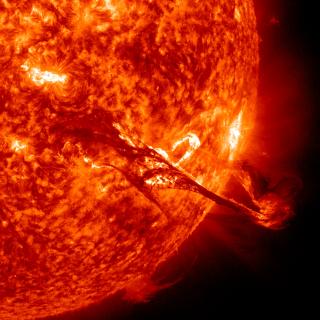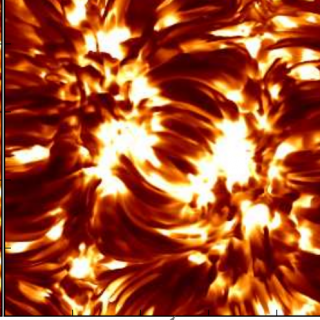Bibcode
Borrero, J. M.; Franz, M.; Schlichenmaier, R.; Collados, M.; Asensio-Ramos, A.
Bibliographical reference
Astronomy and Astrophysics, Volume 601, id.L8, 4 pp.
Advertised on:
5
2017
Journal
Citations
9
Refereed citations
9
Description
Context. The thermal structure of the penumbra below its visible surface
(i.e., τ5 ≥ 1) has important implications for our
present understanding of sunspots and their penumbrae: their brightness
and energy transport, mode conversion of magneto-acoustic waves, sunspot
seismology, and so forth. Aims: We aim at determining the thermal
stratification in the layers immediately beneath the visible surface of
the penumbra: τ5 ∈ [1,3] (≈70-80 km below the
visible continuum-forming layer) Methods: We analyzed
spectropolarimetric data (i.e., Stokes profiles) in three Fe i lines
located at 1565 nm observed with the GRIS instrument attached to the
1.5-m solar telescope GREGOR. The data are corrected for the smearing
effects of wide-angle scattered light and then subjected to an inversion
code for the radiative transfer equation in order to retrieve, among
others, the temperature as a function of optical depth
T(τ5). Results: We find that the temperature
gradient below the visible surface of the penumbra is smaller than in
the quiet Sun. This implies that in the region τ5 ≥ 1
the penumbral temperature diverges from that of the quiet Sun. The same
result is obtained when focusing only on the thermal structure below the
surface of bright penumbral filaments. Conclusions: We interpret
these results as evidence of a thick penumbra, whereby the magnetopause
is not located near its visible surface. In addition, we find that the
temperature gradient in bright penumbral filaments is lower than in
granules. This can be explained in terms of the limited expansion of a
hot upflow inside a penumbral filament relative to a granular upflow, as
magnetic pressure and tension forces from the surrounding penumbral
magnetic field hinder an expansion like this.
Related projects

Solar and Stellar Magnetism
Magnetic fields are at the base of star formation and stellar structure and evolution. When stars are born, magnetic fields brake the rotation during the collapse of the mollecular cloud. In the end of the life of a star, magnetic fields can play a key role in the form of the strong winds that lead to the last stages of stellar evolution. During
Tobías
Felipe García

Magnetism, Polarization and Radiative Transfer in Astrophysics
Magnetic fields pervade all astrophysical plasmas and govern most of the variability in the Universe at intermediate time scales. They are present in stars across the whole Hertzsprung-Russell diagram, in galaxies, and even perhaps in the intergalactic medium. Polarized light provides the most reliable source of information at our disposal for the
Tanausú del
Pino Alemán